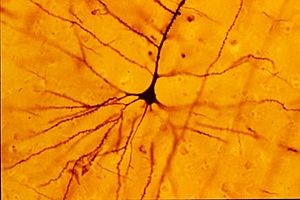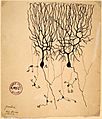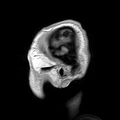Neuroscience facts for kids


Neuroscience is the scientific study of the nervous system. This amazing system includes your brain, spinal cord, and all the nerves throughout your body. Scientists who study neuroscience want to understand how our brains allow us to think, feel, move, and learn. They also study how the brain and nerves work together to control everything we do.
Neuroscience is a huge field that combines many different sciences. It uses ideas from biology, chemistry, computer science, engineering, linguistics, mathematics, medicine, philosophy, physics, and psychology. It also includes genetics, biochemistry, physiology (how living things work), and pathology (the study of diseases).
Contents
What is a Neuron?
The brain is an incredibly complex organ. It is made up of billions of tiny cells called neurons. These neurons work together like a giant network. They form a complex system within your skull, protected by membranes and the brain itself.
Neurons are the basic building blocks of your nervous system. They send electrical and chemical signals to communicate with each other. This communication allows your brain to process information and send messages to the rest of your body.
Modern Neuroscience Today
Today, neuroscience uses many advanced tools and methods. These include molecular biology (studying tiny parts of cells), electrophysiology (measuring electrical signals in cells), and computational neuroscience (using computers to model brain activity).
These modern approaches help scientists understand the brain in ways that were not possible before. They can study how neurons get sick or stop working properly. This helps doctors find new ways to treat diseases that affect the brain and nervous system.
Key Areas of Neuroscience Research
Neuroscience research explores many different topics. Here are some of the main questions and themes scientists focus on:
- How our behavior, cognition (thinking), and language work.
- Understanding Biological rhythms, like our sleep-wake cycle.
- Using brain imaging techniques, like neuroimaging, to see inside the brain.
- Studying Cell biology, which is how cells work.
- Looking at cells with special imaging and measuring their electrical activity with Electrophysiology.
- How we learn and form memories.
- The neurobiology of diseases that affect the nervous system.
- How signals are sent and received within cells.
- The neurobiology of individual neurons.
- How we experience Sensation (like touch or taste) and perception (how we interpret what we sense).
- The science of Sleep.
- How our Autonomic nervous system controls automatic body functions and maintains homeostasis (balance).
- What causes Arousal, attention, and emotion.
- The Genetics of the nervous system.
- How to treat injuries to the nervous system.
Related Fields of Study
Many other fields are closely connected to neuroscience:
- Neurobiology: This is a broad field that studies the biology of the nervous system.
- Neurology: This is the branch of medicine that deals with disorders of the nervous system.
- Psychiatry: This is the medical field focused on mental illnesses and emotional disorders.
Images for kids
-
Drawing by Santiago Ramón y Cajal (1899) of neurons in the pigeon cerebellum.
-
A special type of MRI scan of a head. This patient has benign familial macrocephaly, which means they have a larger than average head size.
See also
 In Spanish: Neurociencia para niños
In Spanish: Neurociencia para niños




